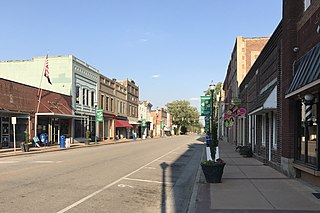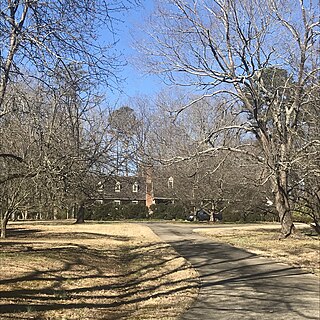
Fremont is a town in Wayne County, North Carolina, United States. The population was 1,255 at the 2010 census. It is included in the Goldsboro, North Carolina Metropolitan Statistical Area.

Goldsboro, originally Goldsborough, is a city and the county seat of Wayne County, North Carolina, United States. The population was 36,437 at the 2010 Census. It is the principal city of and is included in the Goldsboro, North Carolina Metropolitan Statistical Area. The nearby town of Waynesboro was founded in 1787, and Goldsboro was incorporated in 1847. It is the county seat of Wayne County. The city is situated in North Carolina's Coastal Plain and is bordered on the south by the Neuse River and the west by the Little River, about 40 miles (64 km) southwest of Greenville, 50 miles (80 km) southeast of Raleigh, the state capital, and 75 miles (121 km) north of Wilmington in Southeastern North Carolina. Seymour Johnson Air Force Base is located in Goldsboro.

Cliffs of the Neuse State Park is a North Carolina state park in Seven Springs, Wayne County, North Carolina in the United States. It is located near Seven Springs, North Carolina and covers 1,097 acres (4.4 km2) along the southern banks of the Neuse River. It has a swimming area, camp sites, hiking trails, fishing areas, and picnic areas. The park's museum features exhibits about the geology and natural history of the cliffs and the park. Extending for 600 yards (550 m), the series of cliffs rise 90 feet (27 m) above the water. Layers of sand, clay, seashells, shale and gravel form the multicolored cliff face, a rainbow of white, tan, yellow and brown.

Mount Olive is a town in Duplin and Wayne counties in the U.S. state of North Carolina. The population was 4,589 at the 2010 census. It is included in the Goldsboro, North Carolina Metropolitan Statistical Area. The town is home to the Mt. Olive Pickle Company and the University of Mount Olive.

Gertrude Weil was an American social activist involved in a wide range of progressive/leftist and often controversial causes, including women's suffrage, labor reform and civil rights.

Union Station in Goldsboro, Wayne County, North Carolina was built between 1907 and 1909 at West Walnut and North Carolina Streets to serve the Atlantic Coast Line Railroad, the Southern Railway, and the Atlantic and North Carolina Railroad. The architectural design is credited to J.F. Leitner's firm, Leitner & Wilkins. It is a two-story brick building, seven bays wide and two bays deep, with a hip roof, flanked by one-story gabled brick wings. It features a three-story central tower and one-story front and rear porches.

The Sir Walter Hotel is the oldest surviving hotel building in Raleigh, North Carolina. Constructed between 1923 and 1924 on Fayetteville Street and named after Sir Walter Raleigh, the hotel was nicknamed North Carolina's "third house of government," due to its location and being a focal point for state political activity until the 1960s.
William Lee Stoddart (1868–1940) was an architect best known for designing urban hotels in the eastern United States. Although he was born in Tenafly, New Jersey, most of his commissions were in the South. He maintained offices in Atlanta and New York City.
Oheb Sholom is a Reform synagogue located in Goldsboro, North Carolina. It is one of fewer than a hundred nineteenth-century synagogues still standing in the United States, and the second oldest synagogue building in the state.

The Andrew Carpenter House on State Road 1820 in Gaston County, North Carolina, is believed to have been built for Andrew Carpenter shortly after his marriage to Sophia Smith on April 19, 1831. The two-story Federal style plantation house is two rooms deep and has paired chimneys. It is one of the largest early-19th century houses in Gaston County.

Joseph Florence Leitner was an American architect whose work includes several rail stations. In Columbia, South Carolina he worked for Charles Coker Wilson for five years. Later he partnered with William J. Wilkins (architect), first in Florence, South Carolina and then in an office in Wilmington, North Carolina, where Leitner practiced for a decade. to form Leitner & Wilkins. His work included commercial, educational, fraternal religious, industrial, residential, and transportation buildings in colonial revival architecture, Flemish architecture (especially gables, Italianate architecture and Romanesque revival architecture styles. He ended his career in Florida.

The Andrews-Duncan House is a historic building located at 407 North Blount Street in Raleigh, North Carolina, United States. Built in 1874 for a prominent businessman, the Italianate style home was designed by architect George S. H. Appleget. The house was added to the National Register of Historic Places (NRHP) in 1972 and is currently owned by the state government. A large tree named after a presidential candidate once stood behind the house and is commemorated with a historical marker.

Harry Fitzhugh Lee House is a historic home located at Goldsboro, Wayne County, North Carolina. It was built in 1922, and is a two-story, five bay, Colonial Revival style brick dwelling with a gambrel roof and frame shed-roof dormers. A 1 1/2-story gambrel roofed addition was built in 1939. It features a covered porch supported by paired Doric order pillars. It was the home of Harry Fitzhugh Lee, a prominent Goldsboro businessman and a great-nephew of General Robert E. Lee.

Borden Manufacturing Company, also known as Goldsboro Cotton Mills and Wayne Cotton Mills, is a historic factory complex located at Goldsboro, Wayne County, North Carolina. The complex includes the Goldsboro Cotton Mills (1892), Goldsboro Smokestack (1905), Goldsboro Boiler Room, Borden-Goldsboro Pedestrian Bridge, Borden Manufacturing Company (1900), Borden Water Tank, Borden Auto Garage, Borden Reservoir, Borden Reservoir Pump House, Borden Railroad Siding Tracks, Borden Conditioning Room, and Borden Storage Building. The Goldsboro Cotton Mills is a two-story, 16 bays long, gable-front, brick building with Italianate style detailing. It features a central three-story square tower, three bays in width.

L. D. Giddens and Son Jewelry Store is a historic commercial building located at Goldsboro, Wayne County, North Carolina. It was built between 1839 and 1847, and is a two-story, three bay, brick building. It measures 104 feet long and 23 feet, 6 inches wide. It features cast iron ornamentation and a freestanding clock (1877) at the street measuring 14 feet high. L. D. Giddens and Son was founded in 1859 and may be the oldest jewelry store in North Carolina.
John David Gullett was an American architect based in Goldsboro in Wayne County, North Carolina. He practiced in North Carolina from 1920 until his death in 1935. Several of his works are listed on the National Register of Historic Places (NRHP).
James Coor was an architect, builder, politician and leader in North Carolina.
Pleasant Daniel Gold was an American publisher, lawyer, and Baptist minister. Ordained as a Primitive Baptist minister in the Kehukee Association, he was a prominent Baptist leader in North Carolina for over half-a-century. He served as a minister in Rocky Mount, Goldsboro, Wilson, Tarboro, and Durham. In 1867 he co-founded the Baptist newspaper Zion's Landmark, serving as editor until 1920. In 1902 he founded the P.D. Gold Publishing Company, which issued two newspapers for Wilson County.

Charles N. Hunter (1853?-1931) was a Black educator, journalist, and historian from Raleigh, North Carolina. Hunter actively engaged in several late nineteenth-century reform movements. In the 1870s, he participated in the Temperance movement. Beginning in his twenties, Hunter played a significant role as a teacher or principal at the "Colored Graded Schools" in Durham, Goldsboro, and Raleigh as well as at rural schools in Robeson, Chatham, Cumberland, and Johnston Counties. Hunter also helped lead an initiative to build the Berry O'Kelly Training School in Method, N.C.

Green Hill, or Greenhill, is a Federal style plantation house in Hillsborough, North Carolina. The house originally sat on a plantation near Turkey Farm Road, which was given in a land grant by George II of Great Britain to Charles Wilson Johnson. The house was moved to a new location, along U.S. Route 70 Bypass in the late 1960s.


















